Indoor Plants for Full Sun: A Complete Guide
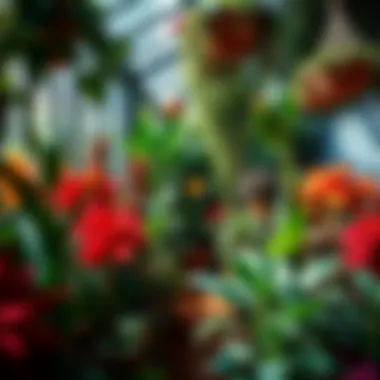
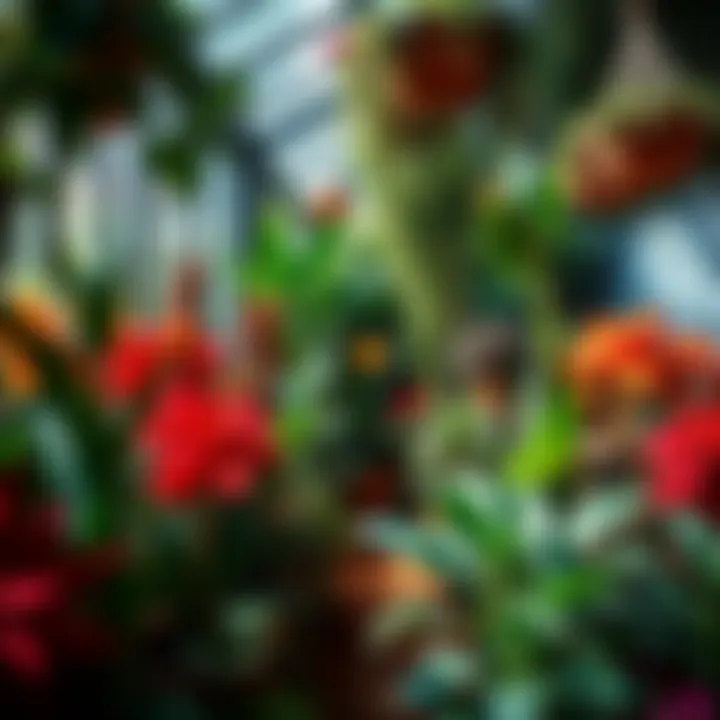
Intro
Indoor plants have long been a favored addition to homes, and as urban living spaces continue to evolve, the fascination with their variety is only growing. As more people recognize the importance of incorporating greenery into their homes, understanding the nuances of plant care becomes vital. This guide will be your compass through the verdant landscape of indoor plants that thrive under full sun, providing insight into their unique characteristics, care requirements, and decorative potential. From ensuring they bask in the sunshine to understanding their specific soil and watering needs, we’ll cover all bases.
The trend of bringing the outdoors inside has gained traction in recent years. Whether filling a sunlit living room with vibrant foliage or dotting a kitchen with hardy succulents, the right plants can not only enliven your space but also create a soothing environment amidst today’s hectic lifestyle. With the proper guidance, anyone can transform their home into a green haven, fostering a connection with nature that might otherwise dwindle in fast-paced routines.
This comprehensive guide serves not just to inform but to inspire. Readers will delve into the brilliant range of full-sun indoor plants, sorted by their unique attributes, how to care for them, common challenges, and many visual and practical tips. Get ready to cultivate your green thumb and discover how the sun-drenched foliage can augment your home decor.
Understanding Full Sun Conditions
Understanding the conditions that define full sun is paramount for anyone aiming to cultivate indoor plants successfully. Creating an environment that fully supports growth involves recognizing various elements, pondering the benefits, and taking specific considerations into account. Knowing how light interacts with your space and how to optimize that can be the difference between a thriving green haven and a collection of sad, wilting leaves.
Defining Full Sun Exposure
Light Intensity and Duration
When discussing light intensity and duration, it’s crucial to grasp that most plants labeled as full sun require direct sunlight for at least 6 hours a day. This intensity can set the stage for substantial growth and vitality. If you consider a standard window allowing for that golden glow, think about how indoor plants bask in the sun’s rays much like a beachgoer soaking up warmth. The essence of this exposure can lead to leaps in growth, but it’s essential to pair it with the right care. An advantage of intense light is that it helps your plants photosynthesize more efficiently. However, too much direct light without adequate watering can scorch delicate leaves, leading to potential mishaps for novice gardeners.
Understanding Natural Light
Natural light isn’t just about sunlight pouring through a window; it’s the blend of ambient light throughout the day, influenced by barriers like curtains or surrounding trees. Many houseplants thrive in different light conditions, and understanding their preferences can hugely affect their growth. For example, some plants may flourish in indirect light while others can’t get enough of that direct sunlight. Proper placement in relation to windows can maximize exposure. A unique feature here is recognizing the angle of light during various times of the year, which can shift dramatically. This creates considerations for placement adjustments over time, ensuring your plants don’t get neglected during seasonal changes.
Impact of Seasonal Changes
The changing seasons have a direct impact on the light available to indoor plants. In winter, for instance, the sun’s path shifts, potentially leaving some plants starved for light. The length of days diminishes, and even if it’s sunny, those rays may not be as potent. Plants may need relocation closer to light sources or supplemental lighting as nature imposes its cycle. An essential aspect of seasonal changes is the need for enthusiasts to stay attuned to their plants’ needs. Being proactive means responding to these shifts — either by adjusting their positions or altering watering schedules based on changing thirst levels during hotter months.
Benefits of Full Sunlight for Indoor Plants
Enhanced Growth Rates
Full sunlight doesn’t just make plants look great; it fuels their growth. When the conditions are right, plants can show enhanced growth rates, making it a desirable aspect. Who wouldn’t want a dazzling fern that seems to grow overnight? The abundant energy from full sun supports rapid photosynthesis, leading to healthier, more robust plants. However, the secret to harnessing this growth lies in recognizing balance; ensure proper watering and nutrients so that the upward growth doesn’t come at the cost of overall vitality.
Improved Leaf Coloration
Think of vibrant green leaves as a statement; they signal that a plant is happy and thriving. Full sunlight contributes significantly to leaf coloration. As plants build chlorophyll, the result is that lush, lively green hue that’s often associated with health. The more light a plant receives, the more pronounced its colors often become. Taking care to provide adequate sunlight can lead to wondrous aesthetics in your indoor garden. But beware — too much light can sometimes lead to leaf burn and fading colors. Finding that sweet spot becomes essential.
Greater Flower Production
For those with a penchant for blooms, full sun can be a boon. Many flowering indoor plants depend on that robust sunlight for spectacular flower production. When plants receive sufficient light, they enter their reproductive phase with zeal, producing blossoms that can brighten up any room. Certain species of succulents and tropical plants are especially endowed when it comes to blooming under full sun conditions. However, if the light is excessive, it might lead to fewer blooms, as certain plants tend to take a break to cope with stress. Monitoring light exposure while anticipating the flowering season is crucial to achieving optimal results.
Choosing the Right Full Sun Indoor Plants
Selecting the right indoor plants that excel in full sunlight is crucial for achieving a vibrant indoor environment. Identifying the specific needs of various plants not only promotes their well-being but also enhances your home aesthetic. Certain plants thrive under high light conditions, which makes them perfect candidates for locations in your home that receive abundant sunshine.
By knowing the characteristics and needs of these plants, you can cultivate a lively indoor garden that brings nature closer to your living spaces. This section explores popular plant varieties adapted to full sunlight, along with the essential considerations for choosing the right ones.
Top Full Sun Indoor Plant Varieties
Succulents
Succulents are a go-to choice for those looking to embrace full sunlight. Their ability to store water in their leaves allows them to withstand dry conditions, making them low-maintenance. You’ll find them in various shapes and sizes, adding visual interest to your space. One of the key characteristics that make succulents attractive is their resilience. They flourish under direct light, enabling them to grow strong and vibrant.
However, one should be mindful; while they prefer full sun, excess water can lead to rot. This unique trait of succulents aids in easy propagation too, making them a great choice for both novice and seasoned plant enthusiasts.
Tropical Varieties
Tropical plants, such as the Ficus elastica or the Bird of Paradise, also deserve a spot in a sunlit indoor arrangement. These varieties thrive in warm, humid environments and benefit from ample sunlight, promoting lush foliage. A noteworthy characteristic is how their leaves usually create a canopy effect, which can refresh and invigorate a space.
Tropical plants not only improve air quality but can also serve as excellent focal points. However, they can be sensitive to sudden temperature changes, which makes humidity control particularly important.
Herbs for Indoor Growth
Herbs such as basil, rosemary, and thyme add not just greenery but also culinary value to your kitchen. They require full sun for optimum growth, which allows for dense and flavorful foliage. One appealing feature of growing herbs indoors is their dual purpose; they beautify your space while being readily available for meal prep.
However, herbs can be a bit finicky with respect to watering – they need regular moisture while also requiring good drainage to prevent their roots from becoming soggy.
Assessing Growth Conditions
Space Requirements
When considering the space required for your full sun indoor plants, it’s important to recognize that these plants can often grow quite large. Space requirements are crucial, as it dictates how well a plant can thrive. These plants often need room to spread, especially those with larger leaves or expansive root systems.
In a small space, such as an apartment, it may be wise to consider compact varieties or those that can grow upwards, such as climbing vines. Ensuring adequate space will not only promote healthy growth but also prevent overcrowding, which can lead to disease.
Temperature Preferences
Most full sun plants thrive in a consistent temperature range, typically between 60°F to 75°F. Understanding temperature preferences is vital because sudden fluctuations can stress the plants significantly. Some tropical varieties may react negatively to drafts or sudden cold snaps, leading to wilting or other issues. Therefore, maintaining a stable temperature can be the difference between a flourishing plant and a struggling one.
Humidity Needs
Humidity can play a central role in the success of your full sun indoor plants. Many species, particularly tropical varieties, prefer humidity levels above 40%. Adjusting humidity might involve using a humidifier, placing a tray of water near the plants, or grouping them together to create a microclimate.
While succulents enjoy drier air, ensuring that tropical plants get enough moisture in the air will contribute to their growth and health. Being aware of the humidity needs often prevents problems like leaf browning and wilting.
By assessing these growth conditions thoughtfully, you can create an indoor space that promotes a thriving garden of full sun plants, enriching both your home life and your experience with nature.
Light Requirements and Placement
When it comes to nurturing full sun indoor plants, the importance of light requirements and placement cannot be overstated. These elements not only dictate the health and growth of the plants but also play a crucial role in how well the plants adapt to the indoor environment. Understanding how to provide adequate light exposure is key to ensuring that these sun-loving plants thrive rather than merely survive.
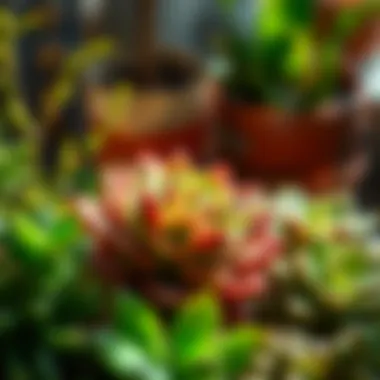
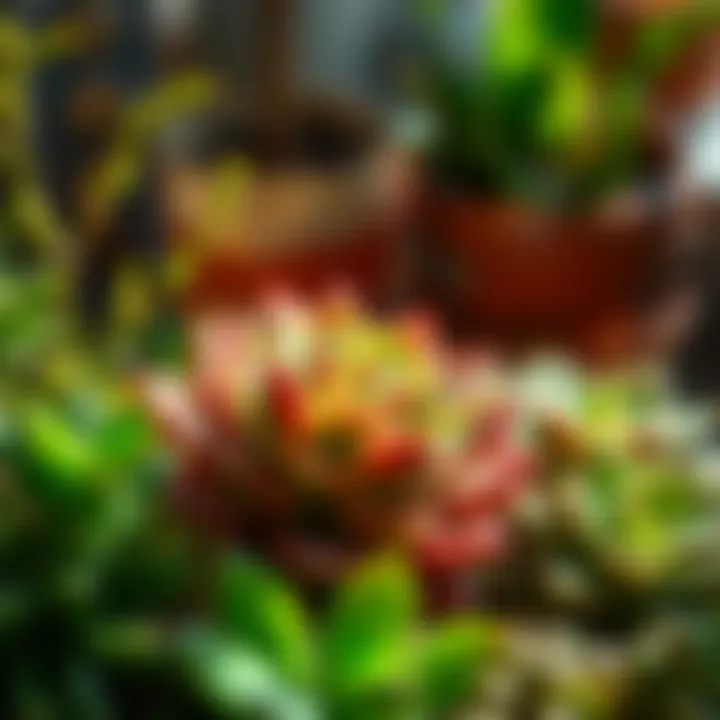
Determining Optimal Plant Placement
Window Orientation
The orientation of windows in your home significantly influences the amount of sunlight your plants receive. A south-facing window is often seen as a goldmine for sunlight, as it typically receives the most direct light throughout the day. This is particularly beneficial for full sun plants that crave intense exposure. On the flip side, east-facing windows offer brilliant morning sun, which can be gentle and less intense, suitable for plants that may be more sensitive to scorching.
One of the unique features of window orientation is how it changes with the seasons. In summer, the sun's trajectory shifts higher, causing shadows to lurk where sunlight once poured in. Conversely, during winter months, the sun sits lower in the sky, making the same window a more prized spot for light-seeking plants. Notably, understanding this aspect helps homeowners avoid potential issues like light burn, where too much sun can scorch delicate leaves.
Room Configuration
The layout of your room is another vital factor in plant placement. An ideal room configuration maximizes light exposure. Plants placed near the center of a well-lit room might receive an adequate amount of natural light, but ensuring they are not overpowered by surrounding objects is key. For instance, if a large curtain blocks the sunlight, it could hinder the growth of even the hardiest of full sun plants.
Moreover, in open-concept living spaces, consider how the sunlight moves throughout the day. Positioning plants in corners where they can catch light from two different angles can be a excellent strategy. An interesting aspect of room configuration is how it can create a harmonious flow of light, allowing diverse plants to coexist while satisfying their individual light preferences.
Seasonal Adjustments
As the seasons change, plants often require careful attention concerning seasonal adjustments. Full sun plants may thrive in the long days of summer but might need a different approach in the winter when daylight becomes scarce. Homeowners should be ready to tweak their indoor arrangements — perhaps pulling plants slightly closer to windows during the winter months to soak up as much light as possible.
A unique characteristic of seasonal adjustments is the natural inclination to shift plants with the sun's path. This could mean rotating pots periodically to ensure all sides receive equal exposure. While some gardeners may feel reluctant to adjust, those willing to embrace change often find their plants respond positively. It’s a gentle reminder that even indoor greenery is attuned to the rhythm of nature.
Supplementing Natural Light
In cases where natural light is lacking, supplementing it becomes essential. This ensures plants receive adequate rays regardless of the season or room configuration.
Artificial Lighting Options
Artificial lighting is a game-changer for indoor gardens, especially when the natural light isn’t cutting it. Simply put, providing additional light can often replicate the sun's nourishing qualities. Options like fluorescent lights or incandescent bulbs are common here, but their effectiveness varies.
Key characteristics like energy efficiency and light spectrum are essential to consider. A major advantage of artificial lighting is its availability on demand, which means plants can receive consistent light without depending solely on natural sunshine. However, one disadvantage is that some types of lights can become quite hot, which isn’t ideal for plant life.
Using LED Grow Lights
LED grow lights are increasingly popular among plant enthusiasts due to their efficiency and versatile spectrum. They mimic sunlight closely, promoting healthy growth patterns in full sun plants. LED lights consume less energy and last much longer than traditional bulbs, making them a cost-effective solution in the long run.
Additionally, their low heat output means they can be placed closer to plants without the risk of scorching leaves. However, they do require investment upfront, and some users need time to familiarize themselves with the best settings for their specific plant types.
Timer Considerations
Incorporating timers into your plant care routine can be a fantastic way to streamline the lighting process. Timers can automatically turn lights on and off, replicating day-night cycles that plants thrive under. This simplicity makes it easier to provide consistent care without having to manually adjust lighting every day.
The unique advantage of using timers is minimizing the possibility of forgetting to turn lights off, thereby avoiding the risk of overexposure. However, one disadvantage might be the initial setup costs, along with ensuring the timer is correctly programmed to match the natural rhythms of your specific plants.
Adjusting lighting and placement strategies may seem laborious at first, but once you find the right balance, your full sun indoor plants will reward you with lush growth and vibrant health.
Soil and Nutritional Needs
Understanding the soil and nutritional needs of full sun indoor plants is paramount. The right soil mix serves as the foundation that supports a plant's overall health and growth. In this section, we will examine various soil components, fertilization techniques, and how to ensure that plants receive the nutrients necessary to flourish in conditions where they maximize sunlight exposure.
Selecting the Right Soil Mix
Aeration and Drainage
Aeration is critical for plant roots, ensuring they have enough oxygen for metabolic processes. Likewise, drainage prevents water from pooling, which can choke roots and lead to rot. An ideal soil mix for full sun indoor plants strikes a balance between retaining moisture and providing the necessary aeration. A key characteristic of good aeration and drainage is the inclusion of materials like perlite or coarse sand, which create spaces for air and help moisture to flow through effectively.
This approach makes the soil light and enables easy root expansion, which is beneficial for growth as it encourages healthier and more robust plants. However, choosing the wrong soil mix can have its downsides. Overly compact soils can hinder drainage and lead to problems, so be mindful of your choices.
Organic vs. Synthetic Options
When it comes to soil, gardeners often debate between organic and synthetic options. Organic soil is generally regarded for its ability to foster biodiversity within the soil ecosystem. This type of soil is rich in natural compost which gradually releases nutrients. On the flip side, synthetic soils often have immediate nutrients available, but they can result in nutrient leaching over time if not managed properly.
One significant feature of organic soil is its ability to retain moisture better than synthetic alternatives, which can be a huge win in a full sun environment where plants may dry out quicker. On the contrary, synthetic options might appeal to those looking for quick results. Each has its advantages and disadvantages, so consider your gardening goals carefully.
pH Levels and Nutrient Content
The pH level of the soil can dictate how well plants absorb nutrients. Most indoor plants prefer a slightly acidic to neutral pH range (between 6.0 and 7.0). Understanding pH levels is crucial for maintaining nutrient availability. Most available nutrients in the soil are at their peak absorption in this pH range, providing the plants with what they need to grow strong.
A unique feature of monitoring pH and nutrient content is the ability to tailor your soil amendments specifically. Using testing kits available at gardening stores, gardeners can adjust the soil's pH with amendments like lime or sulfur, depending on whether they need to increase or decrease acidity. While adapting pH requires a bit of effort, it directly impacts plant health in an environment where full sunlight encourages their demands for nutrients.
Fertilizing Techniques
After establishing the right soil mix, fertilization becomes essential for supplying additional nutrients full sun indoor plants often need.
Frequency and Timing
Determining how often to fertilize and when can often sway the outcome of plant health. Generally, most houseplants benefit from a feeding every four to six weeks, but only during the growing season. A critical point is to avoid fertilizing during dormancy as this can stress the plants unnecessarily.
Being conscious of seasonal changes is a beneficial habit, as their needs can fluctuate throughout the year. Plants exposed to full sun might require more frequent fertilization, particularly during peak growing months, definitely worth considering.
Types of Fertilizers
The choices available for fertilizers can be as varied as plants themselves. Liquid fertilizers are quickly absorbed by plants and can be tailored easily by diluting them to specific strengths. Slow-release fertilizers, on the other hand, feed the plant gradually over time, creating a steady nutrient supply. This slow-feed characteristic can work wonders for plants that thrive on consistent growth patterns, providing a learning curve for indoor gardeners.
In this regard, finding the right type can significantly influence plant vitality, particularly when the plants receive heightened light exposure.
Signs of Nutrient Deficiency
Recognizing signs of nutrient deficiency is crucial. Common symptoms like yellowing leaves or poor growth can indicate a lack of essential nutrients. For instance, nitrogen deficiency can manifest as yellowing of older leaves, while magnesium deficiency often causes interveinal chlorosis.
Being vigilant about these signs creates a proactive approach to plant care, allowing enthusiasts to intervene before issues escalate. Regular observation informs their care habits, as healthy plants are often a result of attentive and spirited gardening practices.
Understanding soil and nutritional needs is not merely a necessary task; it sparks a journey of discovery for plant owners. Adequate soil mixing, thoughtful fertilization, and awareness of deficiencies can yield not just lush greenery, but thriving life within your indoor environment.


Watering Practices for Full Sun Plants
Watering is a cornerstone of successful plant care, especially for those basking in full sunlight. Plants subjected to bright rays demand water not just to survive but to thrive. For full sun indoor plants, having a proper watering routine can make the difference between a flourishing specimen and a languishing one. This guide dives into essential watering practices, allowing you to foster healthy, robust plants while avoiding common pitfalls.
Understanding Watering Needs
Watering Frequency
Watering frequency is all about timing your plant’s care. It can change based on seasons but generally leans toward more frequent watering during hot weather when plants lose moisture quickly. A common rule of thumb suggests checking for dryness a couple of inches down in the soil. If it feels dry, it’s time to give a drink.
This approach is beneficial because it tailors care to individual plant needs rather than applying a one-size-fits-all strategy. One unique feature of watering frequency is the impact of pot size. A larger pot can retain moisture longer compared to a smaller one, thus affecting your watering schedule. Not finding that balance can lead to two extremes: too much or too little, and both are far from ideal.
Signs of Overwatering
Recognizing signs of overwatering is crucial for maintaining the health of your sun-loving plants. Symptoms include yellowing leaves, mushy roots, and a general wilting appearance even when soil is moist. These signs occur because excess water limits oxygen availability, affecting root health.
The importance of identifying these symptoms lies in your ability to act swiftly. If caught early, you can often save a plant from the brink of decline. However, if overlooked, the damage may lead to root rot, a rapid decline, and ultimately, plant death. Keeping an eye on how your plant reacts to watering can save heartache down the line.
Underwatering Symptoms
Underwatering can be just as harmful as its counterpart. Symptoms may not be as immediate but can develop gradually. While the leaf edges might turn crispy and dry, the plant may also show signs of stunted growth or leaf drop. These symptoms can actually sneak up on you as the plant appears to survive in the short term, but the long-term health begins to suffer.
Recognizing these signs early allows you to adjust your watering habits and improve plant vitality. Since most people tend to underestimate plant needs, being aware can help you be proactive rather than reactive. If you notice these symptoms, a thorough soak may be necessary, but do so carefully to avoid shocking the plant.
Effective Watering Methods
Drip Irrigation Systems
Using drip irrigation systems is an efficient method for watering. This method delivers water directly to the roots, reducing waste and evaporation. Ideal for those who might forget to water daily, a drip system ensures that the plant receives a consistent moisture level, which is particularly beneficial in high light conditions.
The standout feature is the precision it offers; you can leave your plants for a few days without worry. However, initial setup may take more time and effort, and not everyone may want to deal with the mechanics. If you’re committed to caring for multiple plants without the daily hassle, it can be a worthy investment.
Bottom Watering Techniques
Bottom watering techniques allow plants to absorb moisture from the bottom up. You place the pot in a saucer of water and allow the soil to draw up what it needs. This is especially beneficial for plants that shy away from water on their leaves, as it reduces the risk of fungal issues.
The unique aspect here is that it encourages deep root growth since the roots naturally reach downward for moisture. However, one must be careful not to overlook regular watering altogether, as plants still require consistent moisture levels. Relying solely on this method isn’t advisable; mixing this with top watering can provide a balanced approach.
Using Moisture Meters
Moisture meters are handy tools for both novice and experienced plant parents. These devices measure soil moisture, taking the guesswork out of when to water. They can help prevent the pitfalls of over and underwatering. Just poke it into the soil, and you’ll receive a reading on moisture levels.
The beauty of moisture meters is in their simplicity. They provide immediate feedback, allowing for quick adjustments to your care routine. On the downside, reliance on technology may limit your intuition about plant care. It’s important to use the readings as guidance but also observe how your plants respond over time.
"A well-watered plant is a happy plant, but over-delivering can lead to more frowns than smiles."
By mastering your watering practices, you’ll not only enhance the vitality of your full sun indoor plants but also cultivate your green-thumb instincts, ensuring a thriving indoor oasis.
Dealing with Common Issues
Understanding how to handle common problems when keeping full sun indoor plants is vital for ensuring their health and longevity. Issues like pest infestations, temperature fluctuations, and humidity can create a challenging environment for plants. Addressing these problems proactively can mean the difference between a thriving plant and one that withers away.
Pest Management for Indoor Plants
Identifying Common Pests
One of the first steps in maintaining the health of your indoor plants is to be vigilant about pests. Common intruders include aphids, spider mites, and mealybugs. These pests are not just annoying; they can cause significant damage to your plants if left unchecked. Signs of infestation might include speckled leaves, sticky residue, or visible bugs.
Being able to correctly identify the pests is crucial. Knowing their habits and signs can help you catch infestations early, providing a better chance for successful treatment. When you’re aware of the common pests that can invade your indoor plants, you can implement appropriate measures and keep these invaders at bay.
Effective Treatment Options
Once pests have been identified, it is essential to act quickly. There are several methods available for treatment, ranging from organic to chemical solutions. An example of a popular organic option is neem oil, which can disrupt the life cycle of various pests without harming your plants or the environment. Learning about different treatment options allows you to find one that suits your needs and your plant care philosophy.
The unique quality of treating infestations early is that it can prevent widespread damage to your plants. It’s essential to monitor your plants regularly to catch any signs before they escalate. Different treatment methods come with their own set of advantages and potential downsides, which should be considered when making a choice.
Preventative Measures
To keep pests at bay, prevention is often the best strategy. Simple practices like cleaning leaves, inspecting new plants before introducing them to your home, and maintaining proper watering can contribute significantly to pest management. Implementing these preventative measures can save time and effort in the long run.
One of the beneficial aspects of these measures is that they create a cleaner environment for your plants, reducing the chances of infestations from the get-go. By being proactive in your approach, you can often enjoy healthier plants with fewer problems overall.
Addressing Environmental Challenges
Temperature Fluctuations
Maintaining stable temperatures is key to the wellbeing of your full sun indoor plants. Most varieties prefer consistent warmth, but can suffer if temperatures swing too widely between day and night or seasons. It’s essential to understand how your home’s heating and cooling systems affect plant temperature.
An important characteristic of temperature fluctuations is that they can stress your plants, leading to slow growth or leaf drop. Understanding this, you can better manage your home environment to keep temperatures even, shielding plants from stress-induced problems.
Humidity Control
Humidity is another contributing factor to the health of your indoor plants. Many species thrive in high humidity, while others may experience leaf curling or browning tips if it's too low. Regular misting, pebble trays, or even humidifiers can help maintain an appropriate level of moisture in the air.
The unique feature of humidity control is that it creates an ideal environment tailored for your plants' needs. However, keep in mind that too much humidity can lead to mold and mildew, so it's about finding the right balance.
Light Burn Prevention
While these full sun plants love bright light, too much direct sunlight can cause leaf burn. It’s essential to know the signs of light burn, such as scorched leaf edges or a bleaching effect on the foliage.
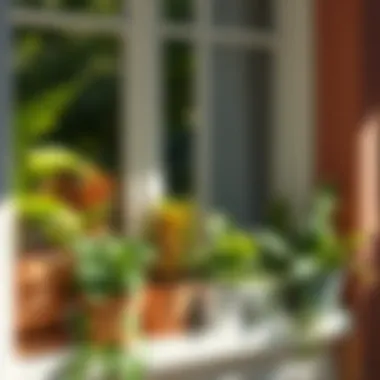
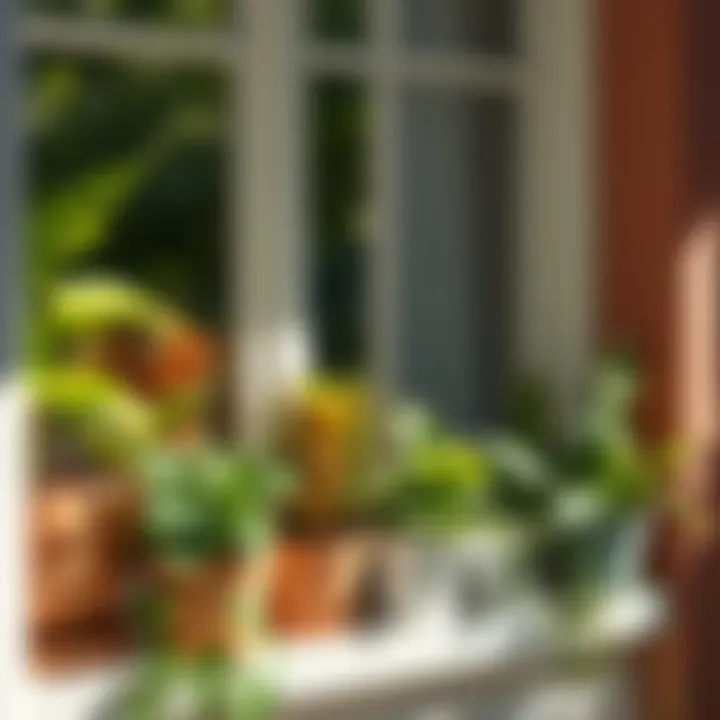
To prevent this, consider adjusting the plant's placement or using sheer curtains during the hottest parts of the day. Understanding how to protect your plants from excessive light ensures they don’t suffer from irreversible damage.
Enhancing Aesthetic Appeal
Creating a lively atmosphere within your home can often be achieved through the thoughtful arrangement of indoor plants. Full sun indoor plants not only thrive with ample light but can also significantly enhance the aesthetic appeal of any space. The way plants are displayed can transform a dull corner into a vibrant oasis. Plants can add colors, textures, and heights that naturally draw the eye.
Using plants as decor isn’t just about response but the creation of an inviting ambiance, merging natural beauty with design. Adding greenery can positively affect mood and provide a sense of tranquility, making one's home feel more alive. It is important then to consider how different plant features, colors, and arrangements work together to bring out the best in every indoor space.
Designing a Full Sun Plant Display
Combining Different Plant Heights
When you mix plants of various heights, it adds depth and dimension to your display. Large plants like the Rubber Plant or Fiddle Leaf Fig create a striking backdrop, while shorter varieties like Succulents or Pothos can form an engaging foreground. This arrangement helps to create a layered look that is visually appealing.
The key characteristic of combining different heights is balance. It allows you to utilize vertical space more efficiently. This is particularly beneficial for smaller rooms where floor space is limited, providing a sense of lushness without overcrowding. An unsteady height distribution, however, can lead to clutter, so careful planning is necessary.
Color Coordination
Color coordination in your plant selection takes the visual aesthetics to another level. Plants with striking foliage colors, such as Croton with its vibrant yellow, red, and green leaves, can complement others like the soothing Peace Lily with its elegant white blooms.
Using a color palette will guide choices in pots and locations. A well-coordinated look harmonizes the space, making it feel curated rather than haphazard. The unique feature of this approach is the ability to evoke certain moods through color, such as calming blues and greens or energizing oranges and yellows. Yet, if too many contrasting colors are used, it could come off as chaotic instead of a pleasant symphony of nature.
Complementary Decor Elements
Adding decor elements that complement your plants can significantly enhance their attractiveness. Textured pots, earthy materials, or natural stones can highlight the plants' organic nature, creating a cohesive look. For example, using terracotta pots with lush greenery can beautifully evoke a Mediterranean feel.
The key characteristic of incorporating decor elements is effective contrast. Textures from fabrics, furniture, and flooring can either amplify or diminish the visual interest of the plants. For instance, a sleek modern pot can stand out beautifully against rustic wooden furniture. Nevertheless, one should ensure that the chosen decor elements don’t distract from the plants themselves, as the goal is to enhance rather than overshadow.
Creating a Focal Point in the Room
Using Standalone Specimens
Standalone specimens act as eye-catching centerpieces in a room. A tall Dracaena or an imaginative Bird of Paradise can command attention when placed in an open spot. These plants draw the eye and create a dynamic focal point, helping to tie the room's decor together.
Standalone plants are a beneficial choice for framing spaces or defining areas within a room. They provide a single, strong element that creates a narrative for the space. However, it is crucial to ensure that these specimens complement the overall decoration, as being overpowering can disrupt the room’s balance.
Crafting Vertical Gardens
Vertical gardens can be a transformative solution for limited indoor space. Using wall-mounted systems, you can cultivate a variety of full sun plants that cascade down, maximizing sunlight exposure and creating an eyecatching visual feature. This type of garden not only looks stunning but also elevates the air quality in the room.
Its unique feature lies in how it utilizes vertical space creatively, which is especially advantageous in smaller homes. Yet, one must carefully consider watering needs and drainage solutions to avoid issues like mold or water damage.
Incorporating Planters and Pots
A well-chosen planter can be just as important as the plant itself. From classic ceramic options to modern metal designs and colorful plastic, the choice of pots adds character to the overall arrangement. For instance, the texture of a rustic wooden pot can contrast beautifully with smooth leaves of a Zamioculcas zamiifolia, also known as ZZ plant.
Incorporating eclectic planters creates a layer of interest, encouraging interactions and dialogues within the space. This approach can also highlight individual plants, increasing their significance in the room. Nevertheless, alignment and consistency in style among the planters is vital, as a disparate assortment can dilute the intended theme.
When arranged thoughtfully, full sun indoor plants not only serve the practical purpose of bringing life indoors but also exhibit personality and a unique design statement.
Culmination: The Journey with Full Sun Indoor Plants
As we wrap up the adventure of incorporating full sun indoor plants into our lives, it’s clear that the journey goes beyond merely watering and positioning these greens in our homes. It’s about crafting a space that radiates vitality, a home full of color and life. Understanding the nuances of care, appreciation for the process, and the delightful surprises these plants can bring are all vital aspects of fostering a thriving indoor garden.
Reflecting on Personal Experiences
The Learning Curve
Every plant enthusiast faces a unique learning curve. This journey might involve navigating the challenges of light requirements and watering practices. A main feature of this curve is the gradual accumulation of knowledge. Each misstep with a wilting succulent or a flourishing pothos teaches valuable insights. When nurturing full sun plants, it’s crucial to acclimatize to their specific needs; this could vary widely. Adapting creates resilience among indoor gardeners, turning initial failures into stepping stones toward success.
On the flip side, there can be frustrations, especially when unique varieties throw unexpected curveballs. These moments might simply call for further research or consultations.
As you hone your green thumb, what once felt like hurdles will, with time, become parts of a rewarding journey.
Cultivating Patience
Patience is another cornerstone of this gardening voyage. Indoor plants, especially the sun-lovers, take time to adjust, grow, and bloom. Observing their slow, deliberate development is paramount. This element of gardening teaches us to resist the urge for instant gratification, which is often at odds with modern schedules and expectations.
The beauty lies in savoring small victories, such as spotting new growth or vibrant leaves unfurling. This reaction often breeds satisfaction far deeper than any fleeting success. Additionally, fostering patience cultivates a mindfulness that transcends plant care; it whispers lessons of life itself.
Enjoying the Results
The ultimate delight springs from witnessing the fruits of your labor. Benefits range from adding freshness to interiors to improving air quality in your home. Each thriving plant becomes a testament to your commitment and efforts. Moreover, when guests notice the lushness around them, it often leads to heartfelt conversations about tips and techniques.
A rewarding sense of connection is also derived from nurturing these plants. They breathe life into spaces, making rooms feel warmer and more inviting. The pride in showcasing your green friends shouldn't be underestimated, creating a delightful atmosphere of achievement.
Potential for Future Expansion
Exploring New Varieties
As the interest in indoor gardening flourishes, so does the variety of full sun plants available. The choice of exploring new species opens a world full of vibrant colors, unique textures, and even fascinating blooms.
Incorporating a variety adds excitement and aesthetic interest to any space. The possibilities seem endless, with options from bold flowering cactus to the delicate appearance of certain tropicals. Embracing diversity among plants caters to individual preferences, allowing decor to evolve based on personality and taste.
While exciting, it requires additional research to ensure compatibility with existing plants. Introducing unfamiliar varieties might also require tailored care approaches. However, investing time into new plant companions often pays off in beauty and satisfaction.
Creating a Plant Care Routine
Establishing a consistent plant care routine caters to the thriving growth of each plant. Knowing how frequently to water, feed, and adjust placements reduces stress for both plants and caretakers. Routines can be as flexible or structured as you prefer, accommodating the dynamic nature of indoor gardening.
A well-defined routine creates a sense of security and predictability, ensuring plants thrive. It aids in tracking health and development over time as well. However, it’s critical to recognize that flexibility will be necessary, as seasonal changes can shift requirements.
Building a Community of Plant Enthusiasts
Engaging with fellow plant lovers can enhance the journey more than expected. Communities offer support, ideas, and resources for tackling common issues, and they celebrate successes collaboratively. Whether through online forums like Reddit or local gardening clubs, sharing experiences and gathered knowledge is invaluable.
Fostering relationships with enthusiasts helps sharpen gardening skills and expand knowledge bases further. Although managing interpersonal dynamics can sometimes be tricky, the friendships forged in mutual admiration for plants can be immensely gratifying.
Investing in a community creates a platform where growth multiplies, not just for plants but for personal connections too.



